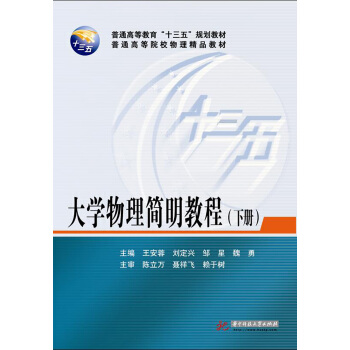![基于流固耦合模型的泥石流运动机理分析(英文版) [Coupled DEM-CFD Analyses of Landslide-Induced Debris Flows]](https://pic.windowsfront.com/12251521/5a7d6924Nf7af6f63.jpg)
基于流固耦合模型的泥石流运动机理分析(英文版) [Coupled DEM-CFD Analyses of Landslide-Induced Debris Flows] pdf epub mobi txt 电子书 下载 2026
- Debris flow
- Landslide
- Coupled DEM-CFD
- Fluid-solid interaction
- Numerical modeling
- Geohazards
- Slope stability
- Granular flow
- Computational mechanics
- Rheology

具体描述
内容简介
This book reflects the latest research results iii computer modelling of landslide-induced debris flows. The book establishes an understancling of the initiation and propagation mechanisms oflandslides by means ot'numerical simulations, so that mitigation strategies to reduce the long-term losses from landslide hazards can be devised.In this context, the book employs the Discrete Element Method (DEM) and Computational Fluid Dynamics(CFD)to investigate the mechanical and hydraulic behaviour of granular materials involved in landslides - an aproach that yields meaningful insights into the flow mechanisms, concerning e.g. the mobilization of sediments, the generation and dissipation of excess pore water pressures, and the evolution of effective stresses. As such, the book provides valuable intormation, useful methods and robust numerical tools that can be successfully applied in the field of debris flow research.
内页插图
目录
1 Introduction to LandsLides1.1 Background
1.2 Terrestrial Landslides
1.2.1 Classification and Characteristics
1,2.2 Major Research on Terrestrial Landslides
1.3 Submerged Landslides
1.3.1 Classification and Characteristics
1.3.2 Major Research on Submerged Landslides
1.4 Model Testing-Granular Column Collapse
1.5 Numerical Investigations
1.5.1 The Finite Element Method
1.5.2 The Smoothed Particle Hydrodynamics
1.5.3 The Discrete Element Method
1.5.4 The DEM-CFD Coupling Method
2 Introduction to Discrete Element Method
2.1 The Discrete Element Method
2.1.1 Particle Motion
2.1.2 The Particle-Particle Contact Model
2,1.3 The Calculation of Stress in the DEM
2.1.4 Coordination Number
2.2 Model Validation
2.2.1 Input Parameters of the DEM Model
2.2.2 Determination of Numerical Time Step
2.2.3 Numerical Simulation of Triaxial Tests
2.2.4 Material Angle of Repose
2.3 Conclusions
3 Investigation of Dry Granular Flows
3.1 The Granular Column Collapse Model
3.2 Dimensional Analysis
3.3 Numerical Simulations
3.3.1 Deformation of the Granular Assembly
3.3.2 Influence of Initial Column Aspect Ratio
3.3.3 Influence of Model Size Ratio
3.3.4 Influence of Column Characteristic Strain
3.3.5 Infiuence of Material Internal Friction Anglr
3.4 Mechanical Analyses
3.4.1 Evolution of Granular Velocity
3.4.2 Granular Energy
3.4.3 Linear Momentum
3.4.4 Flux of Kinetic Energy
3.4.5 Distribution of Kinetic Energy and Linear Momentum
3.4.6 Evolution of Force Chains
3.4.7 Distribution of Stress
3.4.8 Distribution of Coordination Number
3.4.9 Destination of Surface Grains
3.4.10 Influence of Air Viscous Force
3.5 Conclusions
4 Introduction to the DEM-CFD Coupling Model
4.1 Fluid-Solid Interaction
4.2 Governing Equations of Fluid Flow
4.2.1 Fluid Mass Conservation Law
4.2.2 Fluid Momentum Conservation Law
4.3 The Viscous Shear Stress
4.3.1 Laminar Flow Regime
4.3.2 Turbulent Flow Regime,
4.3.3 Near-Wall Treatment
4.3.4 Initial Conditions
4.4 The MPI Implementation and Data Exchange
4.5 Fluid Flow Through a Porous Soil Sample
4.5.1 Analytical Solution of Soil Permeability
4.5.2 Numerical Model Configuration
4.5.3 Laminar Flow
4.5.4 Turbulent Flow
4.6 Numerical lnvestigation of Granular Sedimentation
4.6.1 The Settling of a Single Particle
4.6.2 Batch Granular Sedimentation
4.7 Conclusions
……
5 Investigation of Submerged Debris Flows
6 Conclusions and Recommendations for Future Work
Appendix A: Summary of the Selected Landslides
Appendix B: Calculation of Porosity
Appendix C: Input Parameters for Simulations
References
前言/序言
In recent years, the increasing impacts of landslide hazards on human lives and life-line facilities worldwide has advanced the necessity to find out both economically acceptable and useful techniques to predict the occurrence and destructive power of landslides. Though many projects exist to attain this goal, the current investigation set out to establish an understanding of the initiation and propagation mechanisms oflandslides via numerical simulations, so that mitigation strategies to reduce the long-term losses from landslide hazards can be made.This book summarizes some of the recent researches on landslides via the Discrete Element Method (DEM) and Computational Fluid Dynanucs (CFD). These two methods have been used to investigate the mechanical and hydraulic behaviour of granular materials involved in landslides. The main challenge is to provide rational analyses of large-scale landslides via small-scale numerical simulations. To solve this problem, dimensional analyses have been performed on a simple granular column collapse model. The influence of governing dimensionless groups on the debris runout distance and deposit height has been studied for the terrestrial and submerged granular flows.
3D DEM simulations of granular flows in plane strain conditions have been performed in this research. The input parameters of the DEM model have been calibrated by the numerical triaxial tests, based on which, the relationships between the microscopic variables and the macroscopic soil strength properties were analysed. Using the simple granular column collapse model, the influences of column aspect ratio, characteristic strain, model size ratio and material internal friction angle on the runout distance and deposit height of granular materials have been examined. Additionally, the deformation and energy evolution of dry granular
materials are also discussed. The DEM-CFD coupling model has been employed to study the mechanical and hydraulic behaviour of highly mobilized terrestriaUsubmarine landslides. This model has been validated via numerical simulations of fluid flow through a porous soil sample and grain batch sedimentations. The simulations of granular flows in the submerged environment have led to some meaningful insights into the flow mechanisms, such as the mobilization of sediments, the generation and dissipation of excess pore water pressures and the evolution of effective stresses.
Overall, this study shows that the proposed numerical tools are capable of modelling the mechanical and hydraulic behaviour of terrestrial and submarine landslides.
用户评价
读到这本书的名字,我的脑海里立刻浮现出那些令人心惊胆颤的泥石流灾害画面。标题中的“流固耦合模型”和“DEM-CFD分析”,虽然听起来有些专业,但足以勾勒出作者在探究泥石流运动本质上所付出的巨大努力。我一直对自然灾害的模拟和预测充满热情,而泥石流作为一种极具破坏性的地质现象,其运动过程的复杂性更是吸引着我。我特别好奇,作者是如何将离散元法(DEM)和计算流体动力学(CFD)这两种看似独立的模拟技术有效地融合在一起,以期捕捉到泥石流中颗粒与流体之间那种错综复杂、动态变化的相互作用。 这本书的副标题“Coupled DEM-CFD Analyses of Landslide-Induced Debris Flows”,直接点明了研究的核心——“由滑坡引发的泥石流”,这让我对研究的切入点有了更清晰的认识。滑坡是泥石流的“前奏”,而其引发的泥石流又具有其独特的运动特征。我希望书中能够详细解析,当大规模土体发生滑坡时,是如何在重力、地形以及潜在的水分作用下,演变成具有极高速度和破坏力的泥石流的。DEM模型在模拟滑坡体的失稳和破碎过程上应该能发挥重要作用,而CFD模型则能捕捉到运动过程中伴随的流体动力学效应。 我迫切想知道,书中是如何进行模型构建的。对于DEM-CFD的耦合,其难点在于如何有效地传递和交换不同尺度、不同物理属性的信息。例如,DEM计算颗粒间的碰撞和摩擦,而CFD计算流体的压力和速度场,两者之间如何建立起有效的接口,实现数据的实时同步和迭代计算?我期待书中能有深入的数学推导和算法描述,让我能够理解其中的精妙之处。同时,我也关心模型的求解效率,毕竟大规模的DEM-CFD模拟往往需要巨大的计算资源。 我对书中能否展现出泥石流内部的精细结构和运动过程充满了期待。泥石流并非均匀的流体,而是包含着各种尺寸的颗粒,从细小的泥沙到巨大的石块。DEM-CFD耦合模型,理论上能够模拟出这些颗粒在流体中的运动轨迹,它们之间的碰撞、翻滚、堆积,以及流体对它们的拖曳作用。我希望能看到书中通过模拟结果,呈现出泥石流前锋的冲击特性,内部的颗粒分选现象,以及流体与固体颗粒混合程度的变化。 总而言之,这本书在我眼中,不仅仅是一部关于泥石流的学术专著,更像是一扇通往复杂地质灾害模拟科学世界的窗户。它所采用的先进的数值模拟技术,预示着我们能够以前所未有的精度去理解泥石流的运动机理。我希望这本书能够为地质灾害研究领域带来新的视角和方法,也希望它能为提高泥石流的预警和防治能力提供有力的科学支撑。
评分这本书的标题就足够吸引我了——《基于流固耦合模型的泥石流运动机理分析》,再加上那个英文版的副标题《Coupled DEM-CFD Analyses of Landslide-Induced Debris Flows》,瞬间就点燃了我对复杂地质灾害模拟研究的兴趣。我一直对泥石流这类突发性、破坏力极强的自然现象感到好奇,但仅凭感性的认识,很难深入理解其背后的科学原理。这本书的出现,似乎为我打开了一扇通往微观世界的大门,让我能够以一种更加科学、更加量化的方式去审视泥石流的形成、发展和运动过程。 “流固耦合模型”和“DEM-CFD”这两个关键词,直接触及了现代数值模拟的核心技术。DEM(离散元法)在模拟颗粒介质的变形和运动方面有着独特的优势,而CFD(计算流体动力学)则擅长处理流体动力学问题。将两者相结合,无疑是为了更真实地模拟泥石流这样一种既包含大量固体颗粒又受流体影响的复杂体系。我非常期待书中能够详细阐述这种耦合模型的构建方法、数值求解策略,以及在模型验证过程中所采用的实验数据或野外观测数据。 我对作者如何将复杂的理论模型转化为实际应用充满了好奇。泥石流的发生往往与地形地貌、降雨强度、地震活动等多种因素密切相关,而这些因素的精确量化和纳入模型,无疑是一项巨大的挑战。我希望书中能够深入探讨模型的参数选择、敏感性分析,以及如何通过模拟结果来预测泥石流的发生范围、流速和潜在的破坏程度。如果书中能够包含一些具体的案例分析,例如针对某个特定地区的泥石流模拟,那就更好了,这样我不仅能理解理论,更能看到其在实际工程应用中的价值。 这本书的书名,让我对它在研究方法上的深度充满了期待。泥石流的运动过程,从最初的崩塌、堆积,到形成具有高能量的冲击波,再到扩散、减缓,每一个环节都充满了复杂的物理相互作用。DEM-CFD耦合模型,理论上可以捕捉到颗粒间的碰撞、摩擦,以及颗粒与流体间的动量交换,从而精细地展现出泥石流内部的运动机制。我希望书中能够对这些力学过程进行深入的剖析,例如颗粒流的剪胀、剪缩效应,流体对颗粒的拖曳力和浮力作用,以及这些因素如何协同作用,共同塑造了泥石流的宏观运动形态。 作为一个对泥石流治理和风险评估感兴趣的读者,我非常希望这本书能够提供一些具有启发性的见解。虽然它着重于机理分析,但对于理解泥石流的运动特性,进而提出有效的防治措施,是至关重要的。我希望书中在阐述模型结果时,能够引导读者思考,例如,通过改变某些参数,如颗粒大小分布、含水量等,泥石流的运动轨迹和破坏力会发生怎样的变化?这些模拟结果能否为工程设计提供一些指导性建议,比如如何加固沟谷、如何设置拦挡工程等?
评分看到这本书的题目,我就知道这是一本硬核的学术著作。 《基于流固耦合模型的泥石流运动机理分析》——这个标题本身就充满了信息量。我一直对各种自然灾害的科学解释充满好奇,尤其是像泥石流这样兼具流体和固体特性的复杂现象。当我知道书中使用了“流固耦合模型”和“DEM-CFD”这样的先进技术时,我的兴趣更是被点燃了。 我一直认为,要真正理解一种自然现象,就必须深入到其最基本的构成要素和相互作用机制。泥石流显然不是简单的水流,也不是单纯的土体滑动,它是一个动态的、多相的、充满复杂相互作用的过程。DEM(离散元法)擅长模拟颗粒介质的力学行为,比如碰撞、摩擦、堆积等,而CFD(计算流体动力学)则可以描述流体的运动。将这两种方法耦合起来,我相信作者能够以前所未有的精度来揭示泥石流运动的“微观世界”。 我对书中关于模型构建的细节充满了期待。DEM-CFD耦合模型的设计绝非易事,如何在保持计算效率的同时,保证模型对物理过程的准确描述,这需要高超的理论和技术功底。我希望书中能够深入浅出地介绍模型的离散化方法、耦合方程的建立、数值求解的算法,以及如何处理不同模型之间的信息传递和守恒问题。这些内容,对于理解整个模拟过程的“黑箱”是如何运作的,至关重要。 我最想了解的,莫过于这本书能否为我们揭示泥石流运动的“秘密”。例如,在泥石流形成初期,当滑坡体垮塌时,颗粒是如何破碎、混合,并与可能存在的水分发生相互作用的?当泥石流进入沟道后,其流速、流态以及能量是如何演变的?DEM-CFD耦合模型是否能够模拟出泥石流中颗粒的掺混、分选,以及流体对颗粒的拖曳和阻力效应?我相信,对这些问题的深入解答,将极大地加深我们对泥石流运动机理的理解。 这本书的价值,不仅仅在于理论研究,更在于它可能为实际的泥石流灾害防治提供科学依据。通过精确的模拟,我们可以更好地预测泥石流的发生范围、规模和潜在的破坏力,从而为工程设计、避险措施的制定提供更可靠的参考。我希望书中能够通过实例分析,展示DEM-CFD耦合模型在实际问题中的应用潜力,例如对特定区域泥石流风险的评估,或者对不同防治工程措施效果的模拟验证。
评分读到《基于流固耦合模型的泥石流运动机理分析》这个书名,我立刻被它所蕴含的科学深度所吸引。我一直对大自然的鬼斧神工和背后复杂的物理原理感到着迷,而泥石流这种极具破坏力的地质灾害,更是激发了我强烈的好奇心。标题中的“流固耦合模型”和“DEM-CFD Analyses”这些专业术语,直接表明了这本书将运用当今最前沿的数值模拟技术来解析泥石流的运动机理,这让我对接下来的内容充满了期待。 我尤其对书中如何将DEM(离散元法)和CFD(计算流体动力学)这两种方法“耦合”起来感到好奇。众所周知,泥石流的形成和运动是一个极其复杂的过程,既包含了大量固体颗粒(岩石、土壤、泥沙)的碰撞、摩擦和流动,也涉及流体(水)的动力学效应。DEM擅长模拟颗粒介质的非连续性行为,而CFD则能处理连续介质的流体力学问题。如何将这两种截然不同的模拟范式有机地结合在一起,实现信息的高效交换和相互影响的模拟,这无疑是本书的核心挑战和技术亮点。 我非常希望书中能够详细阐述DEM-CFD耦合模型的理论基础和具体实现方法。从颗粒的本构关系、流体的Navier-Stokes方程,到耦合界面处理、数值求解器选择,每一个环节都至关重要。我期待书中能够有清晰的数学推导和算法描述,让我能够理解作者是如何构建这个“桥梁”,连接起微观的颗粒运动和宏观的流体动力学行为。同时,我也关心模型的计算效率,因为大规模的DEM-CFD模拟通常需要巨大的计算资源,作者是如何对此进行优化和管理的,也十分吸引我。 我对书中能否揭示泥石流运动过程中的一些关键物理现象充满了期待。例如,当滑坡体垮塌并与水体混合时,颗粒是如何破碎、分选,并形成具有高能量密度的泥石流的?在运动过程中,流体是如何影响颗粒的运动轨迹和速度的?颗粒之间的碰撞和相互作用又对整体流态产生怎样的影响?我希望书中能够通过生动的模拟结果,例如三维可视化图像,来展现这些微观层面的相互作用,从而帮助读者建立起对泥石流运动的直观认识。 总而言之,这本书在我看来,是一项对泥石流运动机理进行深度探索的科学研究。它所采用的DEM-CFD耦合模型,为我们提供了一个前所未有的视角,去理解这种复杂的地质灾害。我期待这本书能够不仅在理论上有所突破,更能为实际的泥石流灾害预测、风险评估以及工程防治提供有价值的科学指导。
评分当我看到《基于流固耦合模型的泥石流运动机理分析》这本书时,我的脑海中立刻涌现出那些令人望而生畏的泥石流灾害画面,以及对它们背后复杂运动规律的深深好奇。标题中“流固耦合模型”和“DEM-CFD Analyses”这样的技术关键词,瞬间就勾起了我作为一名对地学模拟和数值计算感兴趣的读者的高度关注。这表明这本书将运用先进的计算科学手段来解析泥石流这一既包含固体颗粒运动,又受流体动力学深刻影响的复杂现象。 我尤其对这本书如何将DEM(离散元法)与CFD(计算流体动力学)这两种在各自领域都享有盛誉的模拟方法进行“耦合”而感到兴奋。DEM在模拟颗粒介质的非连续性、离散性行为方面有着无与伦比的优势,而CFD则在描述连续介质(如水)的流动和相互作用方面表现出色。将两者结合,理论上能够提供一个更加逼真、更加精细的平台,来模拟泥石流这种典型的颗粒流体混合物。我迫切想知道,作者是如何设计这个耦合框架的,是如何解决两种模型在尺度、时间步长、边界条件等方面的差异,并实现高效、准确的信息交换的。 我非常期待书中能够深入探讨DEM-CFD耦合模型在泥石流运动机理分析中的具体应用。例如,当滑坡体崩塌并与水体接触时,DEM模型如何模拟颗粒的破碎、运动和堆积,而CFD模型又如何捕捉流体的渗流、侵蚀以及对颗粒的裹挟和加速作用?在泥石流运动过程中,颗粒的尺寸分布、含水量、流体黏度等因素是如何影响其整体流态、运动速度和破坏力的?我希望书中能通过详细的模拟过程和直观的图件,揭示这些内在的力学联系和演变规律。 我对这本书的科学严谨性和创新性充满了期待。泥石流的运动机理研究是一个长期且充满挑战的课题,而DEM-CFD耦合模型无疑是当前研究的前沿。我希望书中能够展示出作者在模型构建、算法设计、参数选取以及结果解释方面的独到之处和创新贡献。例如,作者是否提出了新的耦合算法,是否开发了高效的并行计算策略,或者是否通过模拟结果解释了一些以往难以理解的泥石流现象。 总而言之,这本书在我眼中,不仅仅是一部介绍泥石流运动机理的学术专著,更是一本展示现代计算科学在复杂地质灾害研究中强大应用潜力的范例。它所代表的DEM-CFD耦合分析方法,为我们理解和预测泥石流这类危险性地质现象提供了全新的思路和工具。我期待它能为学术研究、工程实践以及防灾减灾领域带来重要的启示和价值。
相关图书
本站所有内容均为互联网搜索引擎提供的公开搜索信息,本站不存储任何数据与内容,任何内容与数据均与本站无关,如有需要请联系相关搜索引擎包括但不限于百度,google,bing,sogou 等,本站所有链接都为正版商品购买链接。
© 2026 windowsfront.com All Rights Reserved. 静流书站 版权所有















![国家大地坐标系建立的理论与实践 [Theory and Practice for Establishment of National Geodetic Coordinate System] pdf epub mobi 电子书 下载](https://pic.windowsfront.com/12254332/5a1d40cfN6879a6c0.jpg)



![地球的奥秘:岩石、地震与人的关系 [The secret of the earth: rocks, earthquake and human] pdf epub mobi 电子书 下载](https://pic.windowsfront.com/12255921/5a39c1ddNd201d0e9.jpg)
